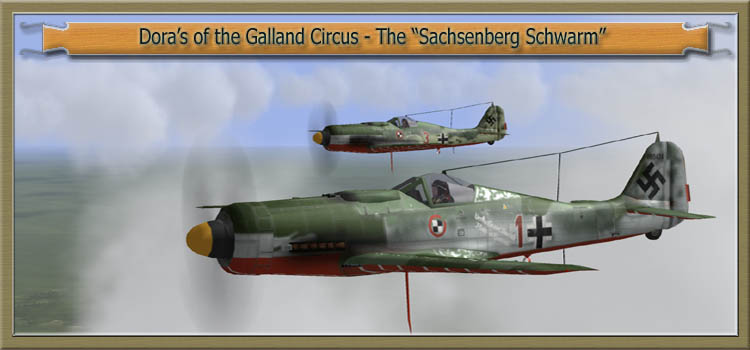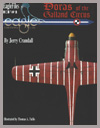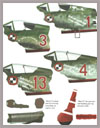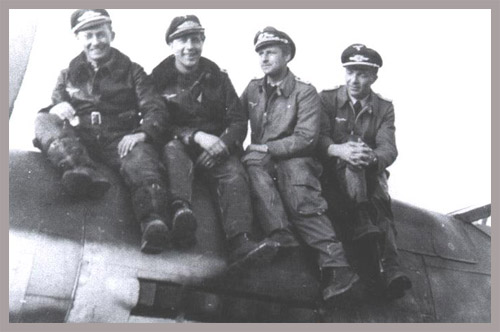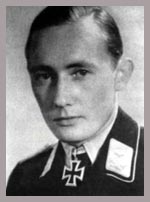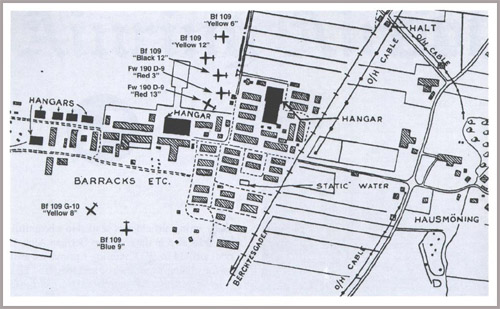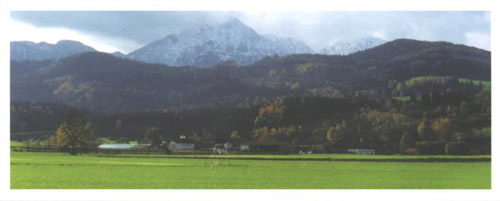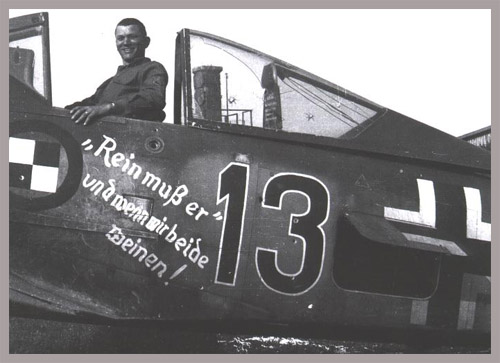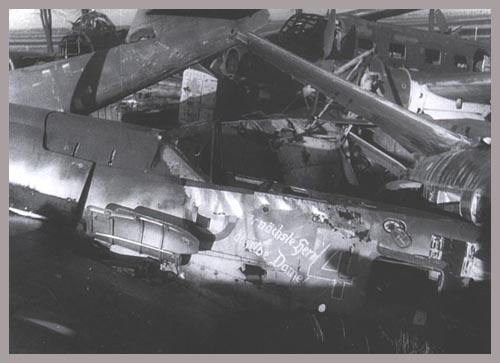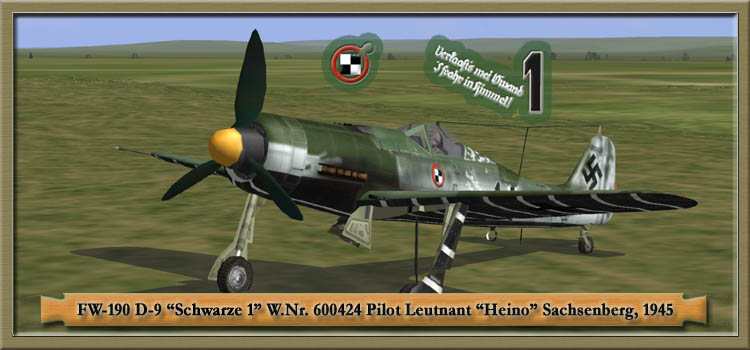|
|
|
1. Informationen zu den FW-190 Dora des "Sachsenbergschwarms" Information to the FW-190 Dora of the "Sachsenbergschwarm"
Die für die Bemalung grundlegenden Informationen erhielt ich aus fantastischen Bildband von Jerry Crandall "Doras of the Galland Circus". Zusätzlich halfen mir Redwulf_1 und Redwulf_2 und das Redwulf-Geschwader beim Fertigstellen und Testen der Bemalungen. Die Informationen zu der fehlerhaften Interpretation der "Rote 1" als "Schwarze 1" stammten aus Magazinen wie der Jet & Prob Ausgabe 3/95, Deutschland.
The information's of this fantastic book "Doras of the Galland Circus" by Jerry Crandall was used for the paintwork. In addition Redwulf_1 and Redwulf_2 and the whole Redwulf-Squad helped me a lot while testing and finishing the paintwork. The information regarding the wrong interpretation of "Red 1" als "Black 1" I got from magazines like the edition 3/95 of Jet & Prob, Germany.
2. Die Piloten der Platzschutzstaffel des JV 44 The pilots of the protection squad of JV 44
Fotografie der bekanntesten Piloten des "Sachsenberg-Scharms" , auf der Roten 3 sitzend von links nach rechts: Photograph of the most known pilots of the "Sachsenberg Schwarm" sitting on Red 3 from left to right: Leutnant Heinz Sachsenberg, (104, Rote 1), Hauptmann Waldemar Wübke (~15, Rote 3), Oberleutnant Klaus Faber (2, Rote 13) und Leutnant Karl-Heinz Hoffmann (?, Rote 4) Quelle/source Jerry Crandall "Doras of the Galland Cicus"
2.1. Biografie von Heinz Sachsenberg Biography of Heinz Sachsenberg
Heinz Sachsenberg Leutnant * 12.7.1922 Dessau/Sachsen-Anhalt RK 9.6.1944 als Fahnenjunker-Feldwebel, DK 17.10.1943, EP 2.10.1943
"Heino", von den Kameraden auch "Wimmersaal" genannt, war der Neffe des Pour-Ie-merit Jagdfliegers Gotthard Sachsenberg. Sein Bruder Gotthard fiel am 8.3.1944 als Nachtjäger.
"Heino", also called "Wimmersaal" by his comerades, was the newhew of the Pour-le-merit awarded WW I fighter pilot Gotthard Sachsenberg. His brother Gotthard was KIA on 8th March 1944 during a night fighter mission.
Er kam Ende 1942 zur 6./JG 52 an die Ostfront und erzielte am 21.4.1943 den ersten Luftsieg. In der Folge schoß er sich rasch nach oben, 19.-22. am 26.7.1943, 24.-27. am 4.8.1943, 31-34. am 12. 8. 1943. Bis Ende 1943 brachte er es auf 52 Abschüsse, obwohl er zwischenzeitlich völlig abgeflogen für mehrere Wochen ausfiel. Nach 76 Luftsiegen wurde er Ende März 1944 zum Ritterkreuz eingereicht, es wurde ihm allerdings erst nach dem 101. Abschuß verliehen. Am 7.5.1944 brachte er sechs Gegner zum Absturz (77.-82.), am 31.5.1944 waren es vier (89.-92.) und am 8.6.1944 erzielte er fünf Luftsiege (97.-101.). Am 23.8.1944 wurde er in Rumänien im Luftkampf mit amerikanischen P-51 Mustang schwer verwundet und machte eine Bauchlandung (Me 109 G-6, 166233, »gelbe 1«). Seine letzten Luftsiege, darunter eine P-51, errang er im März 1945 in Ungarn. Dann schulte er auf Me 262 um und kam zum JV 44 Galland, wo er in der Platzschutzstaffel mit FW 190 D-9 flog. Am 17.6.1951 starb er an den Spätfolgen seiner Verwundung.
Arriving end of 1942 at the eastern front delegated to 6./JG 52 he achieved his first air victory on 21st April 1943. Till 12th of august 1943 he managed top shoot down 34 enemy airplanes. Till the end of 1943 his score climbed up to 52 air victories despite his absences due to overstress for several weeks . After 76 victories he was recommended for the knight cross by end of march 1944, which he was awarded with after his 101st air victory. On the 7th may 1944 he shot down 6 enemy planes, on 31st May four and five on the 8th of June 1944 which gave him a total of 101 air victories! Wounded during an air battle over Rumania with American P-51 Mustang fighters on 23rd June 1944 he managed to belly land with his Bf-109 G-6, W.Nr. 166233 "Yellow 1". He achieved his last victories over Hungaria, among others a P-51. Then he was trained on the Me 262, changing to JV 44 Galland where he pilot the Rote 1 of the protection squad. He deceased on 17th June 1951 suffering from his wartime injuries.
520 Feindflüge / 520 sorties 104 Luftsiege, davon 1 West, 1 Schnellboot versenkt. 84 seiner Abschüsse waren Jagdflugzeuge. 104 air victories, 1 in the west, sunk 1 speed boat. 84 of his victories was fighter planes.
3. Aufgaben der sogenannten Platzschutzstaffel Tasks of the so called airfield protection squad
Die gegen Ende des des Krieges nun wieder als Bomberjäger eingesetzten Düsenflugzeuge der Messerschmitt Me-262 Baureihe waren während des Start und Landevorgangs sehr anfällig gegen Attacken von allierten Tieffliegern. Um hier neben der leichten und mittlere Flugabwehr einen weiteren Schutz zu schaffen, übernahmen Staffelteile des JG 52 und JG 54 die Aufgabe während Start und Landung der Strahlflugzeuge einen Sicherungsschirm zu bilden, um feindliche Tiefflieger abzufangen. Solche eine Staffel bildete auch der "Würger"-Schwarm des JV 44. Galland suchte sich aus den ihm überstellten Flugzeugführern gute, zuverlässige Männer aus, welche die hier gemalten Focke-Wulf D-9 besetzten und bis kurz vor Kriegsende von Ainring, in Oberbayern und München-Riem aus diese Aufgaben wahrnahmen. Um die Maschinen für die eigenen Flugabwehrgeschütze deutlich sichtbar zu machen, erhielten vier dieser Maschinen eine von Hand angebrachte rote Unterseitenbemalung mit weißen Streifen, somit war die Legende der bunten "Papageienstaffel" (dieser Begriff ist erst nach dem Krieg entstanden, und führt somit eine damals nicht bekanntes Nachleben) geboren!
The Messerschmitt Me-262 Jets finally was used again as bomber in bomber hunting missions towards the end of the war. But during take off and landing the jets was very vulnerable to attacks by strafing allied ground attack airplanes. To gave an additional protection beside the light and medium AA-guns around the airfields parts of JG 52 and JG 54 was delegated to fly protective missions to cover the take off and landing phase of the Storm birds. Such a squad was formed by the "Butcherbird"-Squad of JV 44. Galland choose some good and courageous pilots from his commando and formed the famous squad that flew the Focke Wulf D-9 till short time before the end of the war stationed at Ainring airfield in upper Bavaria and Munich-Riem airfield. To make these aircrafts clearly visible to the ground crews of the Anitaircraftgun protection the birds was manually painted to have red underside with white stripes, now the legend of the "parrotsquad2 was born (the name was given after the war and is truly misleading as it was not used by the squad itself!).
4. Historische Aufnahmen zum "Sachsenberg Schwarm" Historical photos refering to the "Sachsenberg Schwarm"
Flugfeld Ainring mit den Positionen der einzelnen Maschinen (Auszug aus einer amerikanischen Kriegskarte nach Besetzung durch allierte Truppen im Mai 1945) Ainring airfield with positions of the planes (Detail of american wartime map after Allied occupation in May, 1945) Quelle/source Jerry Crandall "Doras of the Galland Cicus"
Ainring heute, Blick auf das Hauptgebäude und das Vorfeld Ainring today, view on the main building and the forefield Quelle/source Jerry Crandall "Doras of the Galland Cicus"
"Rote 13" und First Sgt. Jefferson David McGehee (Mai 1945) "Red 1" and "Red 3" und First Sgt. Jefferson David McGehee (May 1945) Quelle/source Jerry Crandall "Doras of the Galland Cicus"
"Rote 4" auf dem Schrottplatz by München Riem (Mai 1945) "Red 4" on the scrap pile at München Riem (May 1945) Quelle/source Jerry Crandall "Doras of the Galland Cicus"
5. Was wäre wenn... Rot oder Schwarz ??? What if... Red or Black ???
Es gab einige Zeitlang heftige Diskussionen, ob die "Rote 1" nicht eigentlich eine "Schwarze 1" oder sogar eine "Blaue 1"sei. Begründet durch das Argument, die Maschine des Staffelführers sollte sich deutlich von den anderen Maschinen unterscheiden, machte dies durchaus Sinn, ist aber nach unterschiedlichen parallelen Untersuchungen eine totale Fehlinterpretation.
Hauptbegündung: Die damaligen Aufnahmen entstanden auf chromatischem Film, der rote Töne als schwarz darstellt. Im Vergleich mit Farbfeldern stellte es sich jedoch heraus, das die Bemalungen und die Nummern der Flugzeuge rot waren. Deshalb gab es die folgende "Schwarze 1" nie !!!
Some times there are discussions if the "Red 1" used to be a "Black 1" or even a "Blue 1". Argument was the common differences in a colour scheme of the squad leader, where his airplane should differ colour wise from the rest of the squad. This is totally wrong!
Main reason: The use of chromatic films during the wartime and some times after showed rote areas as black. Due to closer examinations by different sources it was clearly shown that the colours was red! Therefore the following "Black 1" never exists!
Aber, wer sie jedoch fliegen möchte... Bitte schön :) But, If you like to fly it... please help yourself :)
Focke Wulf 190 Dora 9 "Schwarze 1" W.Nr. 600424 Bemalung mit Markierungen / Paintworks for FB with Markings
© by RaFiGer 2002/2003 All rights reserved.
|
